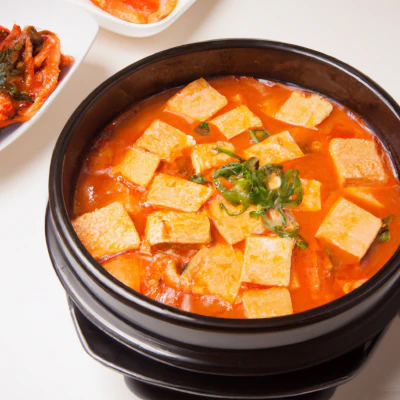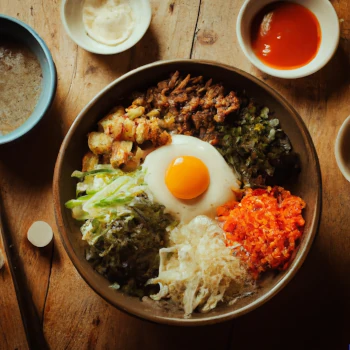Dwenjang Jjigae, Soybean Paste Stew

Dwenjang Jjigae, South Korea's favorite comfort food, is a testament to the wisdom of grannies who knew how to create rich, savory flavors from simple ingredients. This Soybean Paste Soup is more than just a dish—it's a heartwarming experience. As you prepare this dish, you'll find yourself immersed in the process, appreciating the harmony of ingredients coming together. Our recipe brings you this authentic, hearty stew, perfect for any meal. It's a culinary journey into the heart of Korean cuisine, offering a taste experience that's sure to warm your heart and soul.

Ingredients
Dwenjang (soy bean paste) Gochujang (red pepper paste) Gochu garu (ground red pepper flakes) Garlic Onions Green onions or scallions Moo (daikon) Tofu Jalapenos Sesame oil
Method
- 1. Preparation is key to this recipe. Start by mincing several cloves of garlic. Next, slice the onions, daikon, and one whole jalapeno (on a bias) into bite-sized pieces. Cube the tofu similarly. Finally, dice the green onions into tiny pieces.
- 2. Now, let's start cooking. In a large pot, add a little sesame oil and heat it up. Once hot, add the minced garlic to flavor the oil. Pour in 6 cups of water and bring the heat up.
- 3. It's time to add our main ingredients. Put a large scoop of dwenjang (soy bean paste) into the water and stir until it's dissolved. Do the same with a slightly smaller scoop of gochujang (red pepper paste). Add a couple of tablespoons of gochugaru (red pepper flakes) - you can eyeball this.
- 4. Next, add the onions, daikon, and tofu into the pot. Mix gently and let it come to a boil. Then add the diced green onions and sliced jalapenos. Let it cook for a minute.
- 5. Your Dwenjang Jjigae is ready to serve! It's best enjoyed with a bowl of rice. Enjoy this hearty and comforting meal.

Make it a Meal
-

Bibimbap (비빔밥)
A delightful Korean rice dish topped with an assortment of seasoned vegetables, gochujang (spicy Korean chili paste), and your choice of protein such as beef, chicken, or tofu. It's a harmonious blend of flavors and textures.
-

Homemade Gochujang (고추장)
Homemade Gochujang (고추장) is a spicy Korean chili paste made from glutinous rice, fermented soybeans, and red chili pepper flakes. Perfect for adding flavor and kick to Korean dishes like bibimbap, marinating meats, or enhancing soups.
History and Tradition of Dwenjang Jjigae
Dwenjang or Doenjang Jjigae (된장찌개) is a beloved Korean soybean paste stew that has been a staple in Korean households for centuries. This hearty, nourishing dish embodies the essence of Korean home cooking, providing both comfort and nutritional benefits. Deeply woven into the fabric of Korean culture, Dwenjang Jjigae has transcended time, being passed down from generation to generation, with each family adapting it to their own tastes. The rich, umami-packed flavor and the versatility of ingredients make Dwenjang Jjigae an enduring favorite, often considered a soul-warming dish, perfect for a family meal.
At the heart of this dish is dwenjang (된장), a fermented soybean paste, which has been a cornerstone of Korean cuisine for more than 2,000 years. Dwenjang is made through a meticulous fermentation process that involves soybeans, salt, and water, with the creation of meju (메주)—fermented soybean blocks—playing a crucial role. The fermentation process produces a paste that is pungent, earthy, and savory, offering a distinct flavor that is unmatched in Korean cooking.
The origins of dwenjang date back to Korea’s Three Kingdoms Period (57 BCE – 668 CE), when fermented foods became vital for preserving food and providing nutritional value during long winters. Dwenjang, along with other fermented products like kimchi, was created out of necessity as a means to survive harsh winters. Fermented soybean pastes like dwenjang were rich in protein, making them an essential part of the Korean diet. By the Joseon Dynasty (1392–1897), dwenjang had become a household staple, prized not only for its flavor but also for its health benefits. It was believed to aid digestion, boost immunity, and improve overall well-being, making it a daily dietary essential.
The role of Dwenjang Jjigae in Korean meals is much more than just as a source of nourishment. Traditionally, this dish is made to be shared among family members during meals. It is typically served with a steaming bowl of rice, along with a variety of banchan (side dishes), which are often vegetables, kimchi, or pickled items. This communal approach to eating emphasizes the importance of family, togetherness, and the sharing of food in Korean culture.
Even today, Dwenjang Jjigae is central to Korean dining, often served as part of everyday meals, special occasions, or even as a remedy for cold weather. The rich aroma of simmering dwenjang wafts through kitchens across Korea, invoking feelings of nostalgia and home. It’s a dish that reminds Koreans of their roots and the importance of family heritage, blending both tradition and modernity in its preparation and enjoyment. Today, it remains not just a delicious meal but also a cultural symbol, representing the warmth of Korean hospitality and familial bonds.
Unpacking the Unique Korean Ingredients
The distinctive flavor profile of Dwenjang Jjigae is largely due to its key Korean ingredients. These ingredients are not just additions to the stew, but they are pillars of Korean cooking that give Dwenjang Jjigae its authentic, homely taste. Let's explore these essential ingredients:
- Dwenjang: Dwenjang is a fermented soybean paste that forms the foundation of the stew. The fermentation process gives it a deep and complex flavor, contributing to the signature depth and savory richness of the dish.
- Gochujang: Gochujang is a red pepper paste that adds a subtle hint of spice and a touch of sweetness to the stew. It enhances the overall flavor profile and provides a unique umami kick.
- Gochu garu: Gochu garu refers to ground red pepper flakes. It brings vibrant heat to the dish, balancing the flavors and adding a delightful kick that complements the other ingredients.
- Moo: Moo, also known as Daikon, is a white radish commonly used in Korean cuisine. It adds a mild, sweet flavor and a delightful crunch to the stew. The daikon slices in Dwenjang Jjigae absorb the rich flavors of the broth, enhancing the overall taste and providing a satisfying texture.
These ingredients are the essence of Korean cuisine and play an essential role in Dwenjang Jjigae. Their combination, along with the addition of moo (daikon), creates a harmonious symphony of flavors that will transport you to the heart of Korean home cooking. When combined with other ingredients, these Korean gems, including the daikon slices, infuse the stew with an unmistakable taste that truly captures the spirit of Dwenjang Jjigae.
Exploring Variations and Adding Your Personal Touch
Our recipe provides a traditional approach to making Dwenjang Jjigae, but the true beauty of this dish lies in its versatility and the opportunity for personalization. Some variations of the stew incorporate seafood or meat, adding an extra layer of flavor and complexity. Others might include a diverse range of vegetables, such as sliced carrots or Granny's favorite - diced potatoes, contributing to the stew's hearty nature. In fact, the possibilities are endless when it comes to the vegetables you can add to this stew, making each rendition unique and personal. The key to mastering Dwenjang Jjigae is to taste the stew as you're cooking, especially after adding the dwenjang and gochujang. This ensures the balance of flavors is just right and allows you to adjust according to your preference. Remember, Korean recipes are often guided more by taste and intuition rather than precise measurements. So, don't be afraid to trust your palate, experiment with different ingredients, and make the dish truly your own. After all, the best Dwenjang Jjigae is the one that tastes right to you!